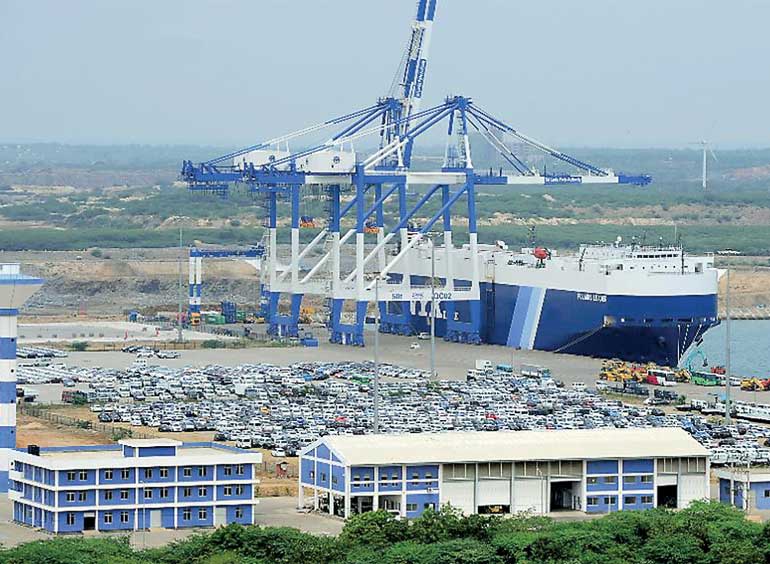Tuesday Jan 07, 2025
Tuesday Jan 07, 2025
Monday, 24 April 2017 00:02 - - {{hitsCtrl.values.hits}}

The Hambantota Port is set to go to China with an impending deal that will see China Merchants take an 80% share for a specified amount of years - AFP Photo / Lakruwan Wanniarachchi
By Wade Shepard
www.forbes.com: As regional powers like China, Russia, Japan, and India vie for political and economic position throughout the eastern realms of Eurasia, many of the less powerful countries caught in the middle are employing what could be called a ‘multi-vector strategy’ as they engage openly with multiple suitors in an attempt to balance out their respective influences - and ultimately bringing in more investment, financing, and development for themselves.
It is a move pioneered, dubbed, and popularized by Kazakhstan — a country which sits right between Russia, China, South Asia, and Europe — in the era following the breakup of the Soviet Union. Rather than being a puppet state of Russia, Kazakhstan began opening itself up to other international powers, bringing in billions in investment and a higher degree of strategic autonomy in the process.
As China advances its program of increased internationalism - as delivered via its Belt and Road initiative - the country has rapidly become a major political and economic power pushing infrastructure development throughout Asia, Eastern Europe, and Africa. More than any other, this new geopolitical player has shaken up the traditional layout of political and economic alliances, creating the counterbalance necessary for more less powerful countries to employ ‘multi-vector strategies’ of their own.
Sri Lanka is such a country. Traditionally aligned with India and the West, this position may have continued ad infinitum if it weren’t for the repercussions that came as a result of how Sri Lanka ended its decades-long civil war against the Tamil Tigers. Dubbed war crimes, the Sri Lankan Government was called up before the UN Human Rights council in 2009, and the EU and US subsequently shut down most economic concessions and sources of aid to demonstrated their disapproval for the alleged abuses.
This resulted in a geopolitical backfire of perhaps unprecedented proportions. Instead of bringing Sri Lanka to submission, the country simply pivoted to China, who was more than willing to “help out” the suddenly politically and economically hamstrung nation. In the years that followed, China gave Sri Lanka $ 37 million in military aid, over $ 8 billion in loans, and the drive to go ahead with multiple Chinese-led mega-projects, such as Colombo Financial City - a $ 1.4 billion, 269-hectare new financial center - and the Hambantota developments, which include a giant deep sea port, an international airport, a cricket stadium, a conference hall, and an impending 15,000-acre, million-worker industrial zone, basically turning the country into a Chinese outpost of progress.
This sheer pivot to China made India feel more than a little ill at ease. A rising global economic and military power was suddenly firmly entrenched on their doorstep, and beyond weightless political posturing they really had no answer for it. It soon became clear that if India was to have any real influence on the island nation to the southeast that they were going to have to jump in, show the money, and build something.
Which has led to this: According to “diplomatic sources” Sri Lanka and India are expected to sign an agreement during PM Narendra Modi’s next visit to Colombo to develop Trincomalee port in the northeast of Sri Lanka.
While this offer to establish a port in this relatively undeveloped part of the country has been on the table for an extended amount of time, before now India never really seemed too interested - at one point basically telling Sri Lank to take their port and shove it. The reason for this rejection has always been the project’s perceived lack of economic viability. (For the record, India also said the same thing when they were invited to be the development force behind Hambantota, long before China came into the picture.) But now India’s perspective on Trincomalee seems to have changed -- and no, its economic appeal has not necessarily been enhanced.
International infrastructure investment and development is no longer merely about profitability: it’s become a way of obtaining influence in a country, a way of countering the position of competing geopolitical forces. India, a country that sorely needs to revive its own aging infrastructure, is now reputedly set to invest $ 2 billion in Sri Lanka. While Japan has committed to investing $ 200 billion in Asian and African infrastructure and Russia is busy building new dry ports and other pieces of transportation infrastructure throughout the post-Soviet realm.
Other global powers are now being pressured to invest in a third party countries in an attempt to keep up with a rapidly internationalizing China, and this is one of the forces that is ultimately bringing the New Silk Road together. It has become very clear to Russia, India, Japan, etc, that if they don’t built it, China will, and countries like Kazakhstan, Serbia, Bangladesh, and Sri Lanka are cashing in on this new great game.
Looked at another way, China is having huge portions of its ‘Belt and Road’ built for them. (Source https://www.forbes.com/sites/wadeshepard/2017/04/21/new-silk-road-or-new-great-game-india-developing-new-sri-lanka-port-to-combat-china/#799461ab206a)
The writer is the author of Ghost Cities of China. I’m currently traveling the New Silk Road doing research for a new book.